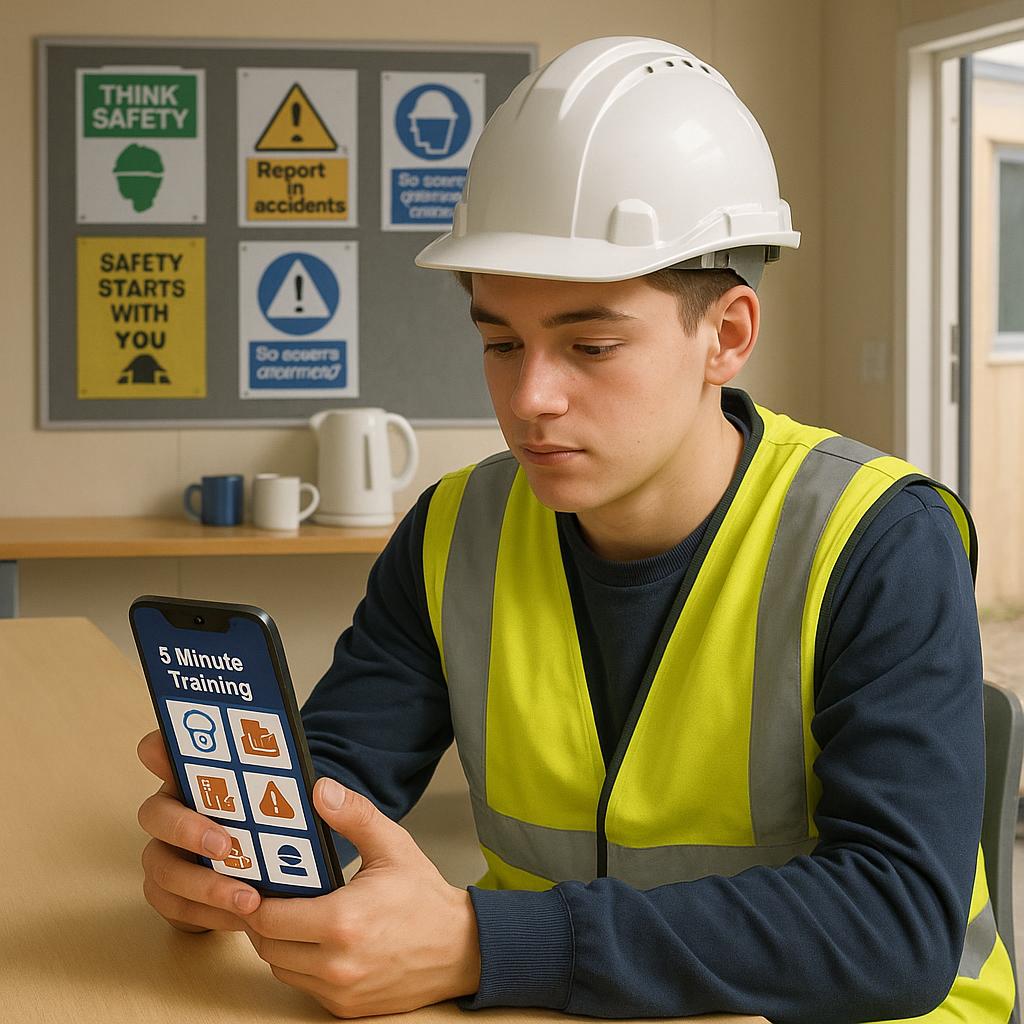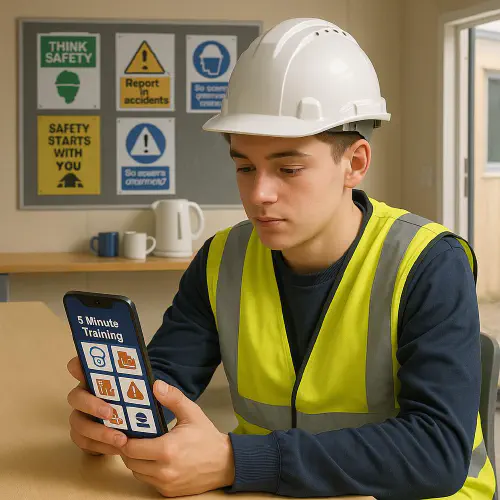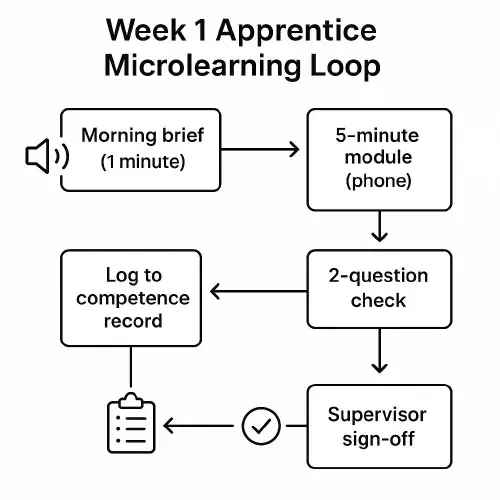
Apprentice week 1 training: 5 minute microlearning modules that stick
Apprentice week 1 training: 5 minute microlearning modules that stick
Category: Hiring, Training and HR Niche: apprentice onboarding, microlearning, competence logs, UK construction

Apprentice in a UK site canteen completing short training modules on a phone
Contents
- Who this is for
- Quick answer
- Why microlearning works on UK sites
- Week 1 plan: five 5 minute modules
- Set up the microlearning loop
- Evidence and records that stand up
- Optional add ons
- FAQ
Who this is for
Small to mid sized trade businesses and site teams that want apprentices productive and safe from day one without dragging them into long classroom sessions. Works for electricians, plumbers, HVAC, carpentry, decorators and general building.
Quick answer
- Run one 5 minute module each morning in week 1. Keep it practical, specific to today’s tasks and finish with two check questions.
- Capture attendance and a simple score, then log to a basic competence record. Repeat key topics weekly for the first month.
- Focus week 1 on the five highest value topics below. Use WhatsApp or SMS to deliver links, and a QR to capture sign in.
Useful references: HSE manual handling, HSE PPE at work regulations, HSE isolation guidance, RIDDOR overview.
Why microlearning works on UK sites
- Short and focused. Five minutes fits a morning brief and sticks better than a long talk.
- Just in time. Learners retain more when training relates to today’s job.
- Easy to evidence. Two questions plus a supervisor sign off gives you a record without paperwork.
- Inclusive. Audio or bilingual versions help mixed language crews. See our guide to translating RAMS and inductions with AI.
Week 1 plan: five 5 minute modules
Design each module with a clear objective, three to five talking points, a 2 question check, and a quick sign off.
Module 1. PPE that actually fits and gets worn
- Objective: apprentice can pick, check and wear the right PPE for today’s task.
- Cover: what the law expects in plain English, site specific PPE rules, how to check gloves, eye and hearing protection, when to replace.
- Quick check examples: Name two times you must change your gloves. What PPE do you need for cutting today?
- Evidence: photo of correctly fitted PPE and two answers logged.
Links: HSE PPE at work regulations
Module 2. Manual handling without a bad back
- Objective: apprentice can move a load using legs, not back, and knows when to ask for help or a trolley.
- Cover: assessing weight and shape, clear route, team lifts, pushing not pulling, break loads down.
- Quick check examples: List two checks before you lift. When should you team lift?
- Evidence: supervisor observes one lift and signs off.
Links: HSE manual handling
Manual handling refresher video:
Watch on YouTube if the video does not load
Module 3. Electrical isolation basics for non electricians
- Objective: apprentice knows not to touch live equipment and can follow a simple isolate tag test rule set for small plant and circuits.
- Cover: who can isolate, lock off and tag basics, proving dead, never bypassing covers, who to call.
- Quick check examples: Name the three steps before working on a circuit. Who signs off isolation on this site?
- Evidence: photo of a tag lock in place or a witnessed toolbox demo.
Links: HSE isolation guidance
Module 4. Near miss and good catch reporting
- Objective: apprentice can spot a near miss and knows exactly how to report it on your job.
- Cover: what a near miss is, why it matters, how to report on your site, what happens next.
- Quick check examples: Give one near miss from yesterday. Where do you send it?
- Evidence: one real or practice near miss submitted.
Links: RIDDOR overview for context
Module 5. Customer care and job notes that prevent callbacks
- Objective: apprentice can take three essential job notes and close out with the customer politely.
- Cover: before and after photos, model and serial, parts used, tidy up, what to say at handover.
- Quick check examples: Which three photos do you always take? What do you say if a customer complains?
- Evidence: one job closed with photos and notes checked by the supervisor.
Related reads: Dynamic risk assessment on site, AI risk assessments for construction
Set up the microlearning loop
Keep the loop the same each day so it is easy to run and track.

Week 1 apprentice microlearning loop: brief, 5 minute module, 2 question check, sign off, log
- Morning brief 1 minute. Explain today’s 5 minute topic and the reason.
- Deliver the module. Use a short note, a one pager or a 90 second audio in WhatsApp.
- Two questions. Ask in person or via a tiny Google Form.
- Sign off. Supervisor confirms they saw the skill done or the answer was right.
- Log it. Save attendance and the two answers to a competence log or spreadsheet.
Helpful how to articles:
- Track attendance with a toolbox talk QR sign in
- Send bilingual voice notes with WhatsApp toolbox talks
- For non English speakers, see our AI translation guide for RAMS and inductions
Evidence and records that stand up
What to file for each module:
- Date, module name, attendee list and score or two answers.
- One proof item if possible. A quick photo or the supervisor’s note.
- Supervisor name and signature or digital tick.
Store safely and only what you need. Follow UK GDPR rules. See the ICO’s guide to UK GDPR.
Want funding help for training longer term Refer to CITB grants and the Apprenticeships service for employers on GOV.UK.
Optional add ons
- Repeat and space learning. Re run the same five modules in weeks 2 to 4 with fresh examples.
- Add a Friday 10 minute recap quiz for the week.
- Build a simple skills matrix using pass or practice again for each module.
- Align with your apprentice onboarding prep using our Apprentice Onboarding Checklist and capture evidence for EPA using this EPA portfolio workflow.
FAQ
How long should each microlearning module be
Aim for five minutes total. One minute brief, three minutes teaching or demo, one minute questions.
Can WhatsApp or SMS count as training evidence
Yes, if you also record attendance and the result of a short check and keep it with a date, topic and supervisor sign off. Use a QR linked form for easy capture.
Do I need to pay apprentices for this training time
Yes. If it is required by the employer and done in work time it is paid work.
What if an apprentice does not have a smartphone
Run the same module as a quick in person demo, record attendance on paper or a shared tablet, then log answers later.
How often should I repeat these topics
Daily in week 1, then weekly for the rest of month one. After that, repeat high risk topics monthly.